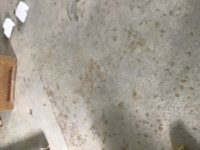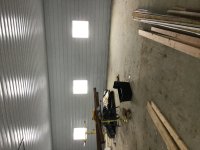You are using an out of date browser. It may not display this or other websites correctly.
You should upgrade or use an alternative browser.
You should upgrade or use an alternative browser.
Failed concrete question
- Thread starter Jeepnford
- Start date
- Views: 5951
More options
Who Replied?
/ Failed concrete question
#31
Gary Fowler
Super Star Member
- Joined
- Jun 23, 2008
- Messages
- 11,998
- Location
- Bismarck Arkansas
- Tractor
- 2009 Kubota RTV 900, 2009 Kubota B26 TLB & 2010 model LS P7010
I wouldn't want any part of that for a shop floor. If needed, go to court to get it resurfaced or as Seabee suggested, pour another slab on top of it. Looks like you already have a building put up so that may not work out.
You might be ok by using a Scabbler or bush hammer to remove an inch or so of material and then put an overlayment on top. You would need to make sure that you got all the spalled concrete removed prior to putting on an overlayment otherwise it would just spall off later. You likely need to have a concrete design engineer or at minimum a professional concrete contractor to evaluate the slab for design strength. You can get core samples to test for actual strength done for a few hundred $$ which is what I would do prior to going to court (you will need this to prove damage or inadequate placement by contractor.
From your description several things happened 1) Water was added to the mix 2)Calcium added which is a no-no 3) Concrete was on the truck too long prior to placement 4) Freezing conditions encountered prior to concrete setting 5) Concrete was not covered and allowed for rain to fall on it before it set.
The rain falling on it could have been mitigated by just covering it with plastic but the other 4 items listed especially the freezing definitely destroyed the strength of it which about the only thing you can do now is place another pour on top.
You might be ok by using a Scabbler or bush hammer to remove an inch or so of material and then put an overlayment on top. You would need to make sure that you got all the spalled concrete removed prior to putting on an overlayment otherwise it would just spall off later. You likely need to have a concrete design engineer or at minimum a professional concrete contractor to evaluate the slab for design strength. You can get core samples to test for actual strength done for a few hundred $$ which is what I would do prior to going to court (you will need this to prove damage or inadequate placement by contractor.
From your description several things happened 1) Water was added to the mix 2)Calcium added which is a no-no 3) Concrete was on the truck too long prior to placement 4) Freezing conditions encountered prior to concrete setting 5) Concrete was not covered and allowed for rain to fall on it before it set.
The rain falling on it could have been mitigated by just covering it with plastic but the other 4 items listed especially the freezing definitely destroyed the strength of it which about the only thing you can do now is place another pour on top.
Streetcar
Veteran Member
I wouldn't want any part of that for a shop floor. If needed, go to court to get it resurfaced or as Seabee suggested, pour another slab on top of it. Looks like you already have a building put up so that may not work out.
You might be ok by using a Scabbler or bush hammer to remove an inch or so of material and then put an overlayment on top. You would need to make sure that you got all the spalled concrete removed prior to putting on an overlayment otherwise it would just spall off later. You likely need to have a concrete design engineer or at minimum a professional concrete contractor to evaluate the slab for design strength. You can get core samples to test for actual strength done for a few hundred $$ which is what I would do prior to going to court (you will need this to prove damage or inadequate placement by contractor.
From your description several things happened 1) Water was added to the mix 2)Calcium added which is a no-no 3) Concrete was on the truck too long prior to placement 4) Freezing conditions encountered prior to concrete setting 5) Concrete was not covered and allowed for rain to fall on it before it set.
The rain falling on it could have been mitigated by just covering it with plastic but the other 4 items listed especially the freezing definitely destroyed the strength of it which about the only thing you can do now is place another pour on top.
Point 1Water can be added to the truck if concrete is designed properly.water should not be added during finishing
Point 2 Calcium is only a no no if reinforced. It is common for road use.
Point 3 is correct, concrete should never be chipped out of chute
Point 4 how cold did it get the night of the pour
Point 5 how hard did it rain. I have seen similar damage from down pour, but not light rain
It will be hard to salvage that slab
Deere Dude
Elite Member
- Joined
- Feb 10, 2011
- Messages
- 4,014
- Tractor
- John Deere 3720
Wow, that is bad. No paint will cover that up. Looks like a tear out possibly. Just a thought, what about leveling compound on the whole floor about 1/2" thick?
Thanks for the pictures.
I really wish you luck with that.
Thanks for the pictures.
I really wish you luck with that.
Gary Fowler
Super Star Member
- Joined
- Jun 23, 2008
- Messages
- 11,998
- Location
- Bismarck Arkansas
- Tractor
- 2009 Kubota RTV 900, 2009 Kubota B26 TLB & 2010 model LS P7010
For surePoint 1Water can be added to the truck if concrete is designed properly.water should not be added during finishing (If designed properly and batched properly, water should not be needed. However some water can be added at beginning of the load to adjust for slump as long as the water / cement ratio is not exceeded. Water should never be added after the initial adjustment for slump
Point 2 Calcium is only a no no if reinforced. It is common for road use. Nothing should be added to the mix design after it leaves the plant unless it is specifically part of the mix design ie onsite use of plasticizer which is always added and mixed just before unloading the load at point of use. If you need a retarder or accelerant then the batch plant should have put it in
Point 3 is correct, concrete should never be chipped out of chute
Point 4 how cold did it get the night of the pour Per ACI 318 specs, concrete should not be placed when temps are expected to go below 40F in then next 24 hours unless plans are made to insulate or heat the concrete.
Point 5 how hard did it rain. I have seen similar damage from down pour, but not light rain Again, easily prevented by spreading plastic over the finished concrete Any added water whether added in the drum or from rain will be bad. Light rain could still cause powdering of the top fractions of an inch of the concrete .
It will be hard to salvage that slab
The rebar was on chairs. It was done the day before. No photos of the pour, misses most of it except for the end, but it was too stiff.Did you take pictures of the pour, or of the rebar before the pour? I've seen so many pictures on here of rebar laying on the ground during the pour that it's become common. Rebar has to be on chairs, there is no other way to keep it off the ground. If they did not have the rebar on chairs, that is further proof that they finisher didn't do a quality job. Pictures will also show the slump of the concrete to some degree. If it's soupy, it will be obvious if you have pictures.
I would be good with something like that or what was mentioned previously, I just don’t know if it would hold up. I’m assuming the top would have to be ground off assuming the rest of it good.Wow, that is bad. No paint will cover that up. Looks like a tear out possibly. Just a thought, what about leveling compound on the whole floor about 1/2" thick?
Thanks for the pictures.
I really wish you luck with that.
ruffdog
Super Star Member
- Joined
- Dec 31, 2011
- Messages
- 12,434
- Location
- southern wisconsin
- Tractor
- Bobcat Toolcat 5610G, Deere X744, Cub Cadet IH 982
One time on "This old house", they used a slurry pour to level a basement floor. Maybe something like that?
MickeyDBC
Gold Member
If you search on youtube for "repair concrete surface" there are a lot of good videos that show up.


